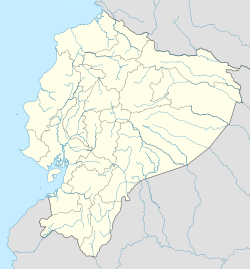Cuenca (Ecuador)
| Cuenca | |||
|---|---|---|---|
| City | |||
| Cuenca, Ecuador | |||

Panoramic view of Cuenca, Ecuador, from Turi area
|
|||
|
|||
| Nickname(s): Atenas del Ecuador (Athens of Ecuador) | |||
| Location in Ecuador | |||
| Coordinates: 2°53′57″S 79°00′55″W / 2.89917°S 79.01528°WCoordinates: 2°53′57″S 79°00′55″W / 2.89917°S 79.01528°W | |||
| Country | Ecuador | ||
| Province | Azuay | ||
| Canton | Cuenca Canton | ||
| Founded | April 12, 1557 | ||
| Founded by | Gil Ramírez Dávalos | ||
| Named for | Cuenca, Spain | ||
| Parishes |
Urban Parishes
|
||
| Government | |||
| • Mayor | Marcelo Cabrera | ||
| Area | |||
| • City | 70.59 km2 (27.25 sq mi) | ||
| Elevation | 2,560 m (8,400 ft) | ||
| Highest elevation | 2,550 m (8,370 ft) | ||
| Lowest elevation | 2,350 m (7,710 ft) | ||
| Population (2015)INEC estimates | |||
| • City | 400,000 | ||
| • Density | 5,700/km2 (15,000/sq mi) | ||
| • Metro | 700,000 | ||
| The population total is of the urban parishes of the Municipality of Cuenca (the canton), which make up the city of Cuenca; the metro population is the population of the canton cuenca, areas urbanas of azogues , biblian and deleg in the cañar province. Gualaceo and Paute in the azuay province. | |||
| Demonym(s) | Cuencan | ||
| Time zone | ECT (UTC-5) | ||
| Postal code | 010150 | ||
| Area code(s) | (+593) 07 | ||
| Climate | Cfb | ||
| Website | Official website (Spanish) | ||
 The Catedral Nueva |
|
| UNESCO World Heritage Site | |
|---|---|
| Area | 70,590,000 m2 (759,800,000 sq ft) |
| Criteria | ii, iv, v |
| Reference | 863 |
| Coordinates | 2°54′08″S 79°00′19″W / 2.902222°S 79.005261°W |
| Inscription | (Unknown Session) |
| Website | www |
|
[]
|
|
The city of Cuenca — in full, Santa Ana de los Cuatro Ríos de Cuenca — is the capital of the Azuay Province. It is widely regarded as the most European city in the country of Ecuador due to its 16th and 17th century era Spanish colonial architecture resembling cities and architecture throughout Spain. The city of Cuenca is located in the highlands of Ecuador at about 2,500 metres (8,200 feet) above sea level, with an urban population of approximately 400,000 rising to 700,000 inhabitants in the larger metropolitan area. The centre of the city is listed as a UNESCO World Heritage Trust site due to its many historical buildings.
According to studies and archeological discoveries, the origins of the first inhabitants go back to the year 8060 BC in the Cave of Chopsi. They were hunters, hunting everything the Páramo offered them, and nomads, following the animals and seasons. Their culture is represented by tools such as arrows and spears, which have been found throughout the Andean valley. The culture was most present about 5585 BC.
Later the early indigenous people used the stable climate, fertile soil and abundant water to develop agriculture. They grew potatoes, melloco, chocho, squash and quinoa. They also domesticated animals such as cuys, and camelids: llamas and alpacas.
Their technology was also advanced. For example, they started creating ceramics. In fact, ceramics constitute the greatest number of artifacts which archeologists use to study their culture. The period from 5000 BCE to 2000 BCE is not represented well in the archeological record. Beginning around 2000 BCE, the people developed a more highly organized society, demonstrating delegated responsibilities, such as the managing of water and control of plagues. People were specialized as administrative and religious authorities (known as shamans). This occurred during the periods of Chaullabamba, Huayco, Pirincay, Monjas, Putushio, Huancarcucho and Jubones. From then until 500 AD began the periods of Tacalshapa III and the Cañari people, who were absorbed into the Incas in the 15th century.
...
Wikipedia




